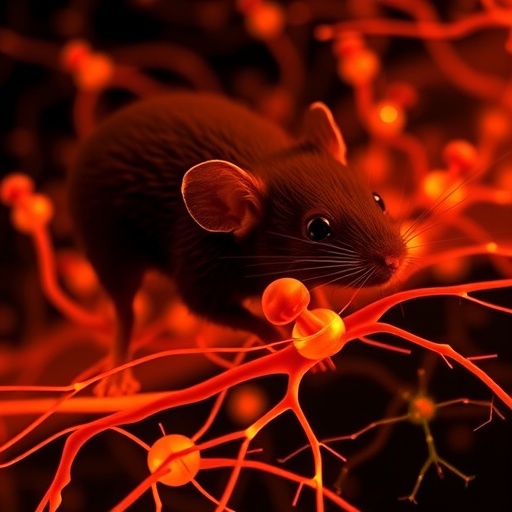In a groundbreaking study published in Cell Reports, neuroscientists at Kobe University have uncovered a specialized neural mechanism that governs social familiarity and empathetic behavior in mice. This discovery sheds crucial light on how specific brain circuits regulate social preferences and decision-making, with profound implications for understanding neuropsychiatric conditions such as autism spectrum disorder and schizophrenia. The research focuses on parvalbumin-expressing (PV) interneurons within the insular cortex—a brain region critical for integrating emotional and social information.
Social behavior is inherently complex, involving dynamic choices about whom to engage with and how long to sustain interactions. For example, individuals preferentially attend to distressed friends, offering consolation, while simultaneously balancing attention between familiar and novel peers. These social decisions rely on finely tuned neural circuits. Previous studies have implicated disruptions in such circuitry in various psychiatric disorders, but the specific cellular components orchestrating these behaviors remained unclear until now.
Lead researcher TAKUMI Toru and his team employed advanced techniques combining genetic engineering and cutting-edge in vivo imaging to probe neuronal activity with unparalleled precision. By implanting miniature endoscopic cameras directly into the brains of genetically modified mice, the researchers could observe the activity of PV interneurons in real time during social encounters. These interneurons, known for their rapid firing and inhibitory control within neural networks, were hypothesized to modulate social preference behaviors.
The experimental design included selectively dampening the activity of PV interneurons via genetic modification to observe resultant behavioral changes. Remarkably, mice with inhibited PV interneurons displayed aberrant social recognition patterns. Unlike control mice, which spend less time with familiar conspecifics compared to strangers, these altered mice showed no such discrimination, engaging equally with both known and unknown peers. This finding indicates that PV interneurons play a critical role in encoding social familiarity, acting as a neural gatekeeper that influences social choice.
In addition to social recognition deficits, these PV-interneuron-inhibited mice failed to exhibit empathetic responses typically observed in healthy mice. When presented with a choice between a stressed peer and a non-stressed peer, normal mice preferentially approached and spent more time with the stressed individual—a behavior indicative of consolation or empathy. The genetically modified mice, however, did not demonstrate this preference, suggesting a breakdown in emotional recognition or processing pathways.
Intriguingly, when mice were allowed unrestricted social interaction without assigned choices, the inhibited group did not differ significantly in overall social behavior from their control counterparts. This nuanced observation suggests that PV interneurons do not govern social behavior broadly but selectively modulate the preference hierarchy and empathic bias within social networks. As a “switch” in the social brain network, these interneurons arbitrated targeted social decisions rather than general sociability.
These insights highlight the insular cortex’s PV interneurons as key modulators in the brain’s social information processing pipeline. The insular cortex functions as a hub for integrating sensory, emotional, and cognitive signals; therefore, disruptions in this circuitry could underpin the social cognition deficits frequently observed in neuropsychiatric disorders. Prior clinical observations have noted abnormalities in PV interneurons in postmortem analyses of brains from patients with schizophrenia and autism spectrum disorders, but direct causal links were lacking until now.
The methodological innovations of this study are noteworthy. The team’s use of genetic tools enabled selective suppression of targeted interneurons, while real-time imaging provided unprecedented resolution of neural dynamics during behavior. This approach allowed the researchers to correlate specific neuronal activity with discrete elements of social interaction, advancing our mechanistic understanding beyond correlational studies.
Beyond basic neuroscience, these findings pave the way for translational research targeting PV interneurons. By elucidating how these cells regulate social recognition and empathy, new therapeutic strategies could be developed to restore or modulate their function in patients suffering from social impairments. Modulating PV interneuron activity pharmacologically or via neuromodulation techniques may hold promise as interventions for autism or schizophrenia spectrum conditions.
Future research extending these findings to human subjects and other animal models will be imperative. Comparative studies could assess whether similar interneuronal circuits operate in human insular cortex and how genetic or environmental factors may alter their function during development. Such investigations can refine our understanding of the neural substrates of social cognition and identify biomarkers for early diagnosis.
This study was supported by extensive funding from multiple Japanese scientific organizations, including the Japan Society for the Promotion of Science, the Japan Agency for Medical Research and Development, and the Japan Science and Technology Agency. Collaborative efforts with Hokkaido University and Kyoto Institute of Technology underscore the interdisciplinary nature of this research endeavor.
Kobe University, renowned for its comprehensive research programs, continues to contribute substantially to neuroscience by integrating genetic, behavioral, and neuroimaging methodologies. Their work exemplifies the cutting-edge approaches required to unravel the complexities of social brain function and its disturbances in disease.
As the neuroscience community seeks to decode the biological basis of human sociality, the identification of PV interneurons as pivotal regulators opens new windows into the neural logic underlying empathy and social familiarity. Such insights not only deepen scientific knowledge but also bear significant societal relevance given the pervasive impact of social cognition disorders.
The promising trajectory established by Takumi and colleagues anticipates that therapeutic modulation of interneuron function in the insular cortex could one day mitigate the profound social impairments endured by millions worldwide. Understanding the cellular “switches” controlling social preference and empathetic behavior is an essential foundation for this transformative endeavor.
Subject of Research: Animals
Article Title: Parvalbumin interneurons in the insular cortex control social familiarity and emotion recognition
News Publication Date: 26-Aug-2025
Web References: http://dx.doi.org/10.1016/j.celrep.2025.116085
References: Cell Reports, DOI 10.1016/j.celrep.2025.116085
Image Credits: Kobe University, with material from Brennan Burling via Unsplash, Understanding Animal Research, National Institutes of Health
Keywords: parvalbumin interneurons, insular cortex, social behavior, empathy, neuropsychiatric disorders, autism spectrum disorder, schizophrenia, neuroscience, neural circuits, social cognition




